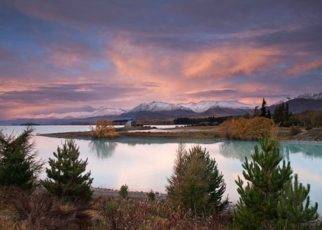The colours of New Zealand have always delighted travelers. Legend has it that when Maori caught sight of the North Island more than 1000 years ago, they christened their new homeland Aotearoa, commonly translated as “Land of the Long White Cloud”. A later newcomer, writer Greg Kelly likened the country to a “Land of Green Blankets” (Gun in the Case, Hodder & Stoughton, 1968).
New Zealand has so Many Textures, Colours and Shapes
“It’s like seeing the world in HD because everywhere you look when you’re out and about there are so many textures and colours and shapes,” said British journalist Paul Smith. “There are far too many to squeeze into your eyes.” Smith, the world’s first “Twitchiker”, arrived in New Zealand on 23 March 2009 after completing his mission to travel as far as he could in one month using only transport and accommodation offered through networking website Twitter.
New Zealand’s famed Pink and White Terraces were destroyed during the 1886 eruption of Mount Tarawera, but in the volcanic hinterland steam-wreathed silica terraces still gleam with shades of amber, earth, gold and rose. Clear turquoise water bubbles from both hot and cold mineral springs. At Wai-o-tapu the terraces are primrose, and visitors can enjoy the spectacle of the Champagne Pool – a fifth of an acre of bubbling water with an ochre-coloured petrified edge.
Traditional Colours have been Incorporated into Contemporary Architecture
The colours of bone, earth-red and umber traditionally used by Maori for carving, building and weaving with flax and fibre have been incorporated into contemporary architecture. In Rotorua, the tourist centre of the volcanic heartland, many civic buildings are adorned with these organic colors. Near Rotorua also are the Blue and Green lakes, set like jewels into their surroundings of steep, forested hills.
Within a short distance of any urban area visitors may find gently rolling grass-covered hills, rugged hill country or large tracts of native or man-made forests and wilderness areas. Indigenous trees and shrubs are non-deciduous so the countryside appears green at most times of year, providing a verdant backdrop for introduced species of poplars, willows, pines and many other plants that have found footage in the New Zealand landscape.
Golden-Brown Tussock Areas are Guarded by Snow-Capped Mountains
Through the centre of the North Island and down through the South Island, golden-brown tussock areas stretch for miles, with snow-capped ridges and mountains standing sentinel in the distance. In many parts of the country, vineyards and orchards add colour and texture to the landscape. New Zealanders are often keen gardeners and it’s worth taking a drive into the suburbs to see garden plots that complement the larger and beautifully maintained public gardens to be found in most cities and towns.
Autumn is a Lovely Time to Experience New Zealand
On the west coast the Tasman Sea breaks onto rocky black-sand beaches, while on the east coast sunbathers enjoy long sweeps of golden-white sand washed by the waters of the Pacific Ocean. If swimming and sunbathing are not priorities, a lovely time to see New Zealand is during March-April. The weather is often glorious at this time of year when the edge of winter takes a bite out of the sometimes-fierce summer heat and the golden colours of autumn highlight the landscape.





